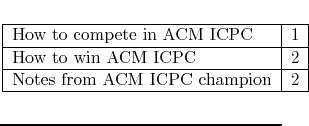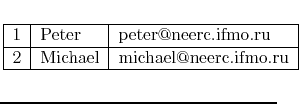Problem 036——UVa 1592 - Database
来源:互联网 发布:网络数据库技术 编辑:程序博客网 时间:2024/06/11 16:38
Peter studies the theory of relational databases. Table in the relational database consists of values that are arranged in rows and columns.
There are different normal forms that database may adhere to. Normal forms are designed to minimize the redundancy of data in the database. For example, a database table for a library might have a row for each book and columns for book name, book author, and author's email.
If the same author wrote several books, then this representation is clearly redundant. To formally define this kind of redundancy Peter has introduced his own normal form. A table is in Peter's Normal Form (PNF) if and only if there is no pair of rows and a pair of columns such that the values in the corresponding columns are the same for both rows.
The above table is clearly not in PNF, since values for 2rd and 3rd columns repeat in 2nd and 3rd rows. However, if we introduce unique author identifier and split this table into two tables -- one containing book name and author id, and the other containing book id, author name, and author email, then both resulting tables will be in PNF.


Given a table your task is to figure out whether it is in PNF or not.
Input
Input contains several datasets. The first line of each dataset contains two integer numbers n and m ( 1Output
For each dataset, if the table is in PNF write to the output file a single word ``YES" (without quotes). If the table is not in PNF, then write three lines. On the first line write a single word ``NO" (without quotes). On the second line write two integer row numbers r1 and r2 ( 1Sample Input
3 3How to compete in ACM ICPC,Peter,peter@neerc.ifmo.ruHow to win ACM ICPC,Michael,michael@neerc.ifmo.ruNotes from ACM ICPC champion,Michael,michael@neerc.ifmo.ru2 31,Peter,peter@neerc.ifmo.ru2,Michael,michael@neerc.ifmo.ru
Sample Output
NO2 32 3YES
#include<iostream>#include<cstdio>#include<string>#include<sstream>#include<cstring>#include<map>#include<algorithm>using namespace std;map<string ,int > maps;int p[10008][6];int main(){ int n,m;lop:while(cin >> n >> m) { string s,t; maps.clear(); memset(p,0,sizeof(p)); getchar(); int k=0; for(int i=1; i<=n; i++) { getline(cin , t); for(int j=0; j<t.length(); j++) { if(t[j]==' ') t[j]=','; else if(t[j]==',') t[j]=' '; } stringstream tt(t); for(int j=0; j<m; j++) { tt >> s; map<string,int>::iterator it; it=maps.find(s); if(it!=maps.end()) { p[k][0]=maps[s]/10; p[k][1]=maps[s]%10+1; p[k][2]=i; p[k][3]=j+1; k++; } maps.insert(map<string,int>::value_type(s,i*10+j)); } } if(k==0||k==1) cout << "YES\n" ; else { for(int i=0; i<k; i++) for(int j=i+1;j<k;j++) { if(p[i][0]==p[j][0]&&p[i][2]==p[j][2]&&p[i][1]==p[i][3]&&p[j][1]==p[j][3]) { printf("NO\n%d %d\n%d %d\n",p[i][0],p[i][2],p[i][1],p[j][1]); goto lop; } } } } return 0;}- Problem 036——UVa 1592 - Database
- UVA - 1592 Database
- UVa 1592 - Database
- UVa 1592 Database
- UVA 1592(p128)----Database
- UVA 1592 Database
- UVa 1592 Database
- Database UVA 1592数据库
- Uva 1592 Database
- uva 1592Database
- Database, UVa 1592
- UVA 1592 Database(map)
- UVa 1592 Database
- uva-1592Database[STL应用]
- UVA - 1592 Database map+pair
- Problem 028——Uva 101 - The Blocks Problem
- Problem 002——UVa 10082 - WERTYU
- Problem 007——UVa 1585 - Score
- C#复习_不使用第三个变量交换两个int类型变量的值
- SyntaxError: Non-UTF-8 code starting with '\xc1' in file.
- JUnit4---eclipse中使用JUnit4进行单元测试、快速上手指南
- 什么是Quartz2D以及Quartz2D有什么功能?
- Android ViewTree and DecorView
- Problem 036——UVa 1592 - Database
- Web.xml加载顺序
- Ubuntu 14.10/15.04 安装经典菜单指示器
- 优化数据页面(4)——使用加粗字型突出标题行
- Android高手之路之获取正在运行的service,以及判断某个service是否正在运行
- 栈和堆的数组访问之异
- Spark源码分析(七)存储管理2
- Swift学习(逻辑篇)
- sys_sendto的函数实现


